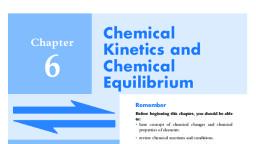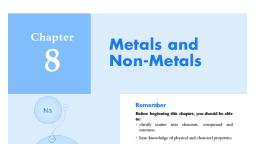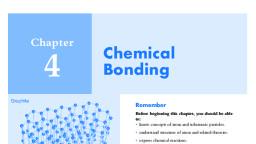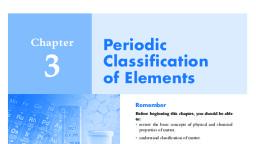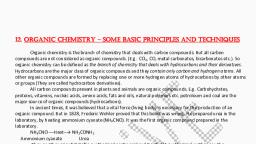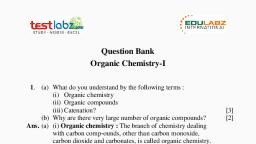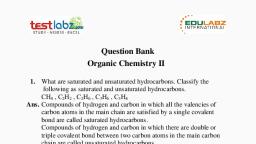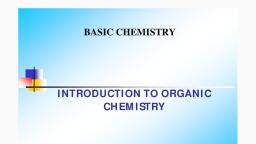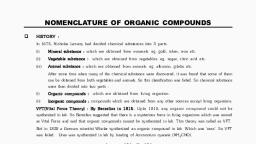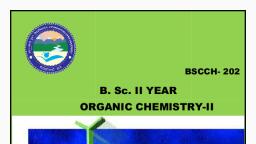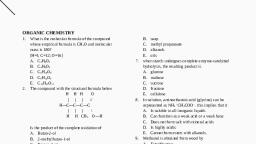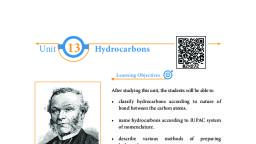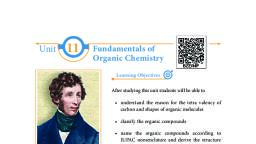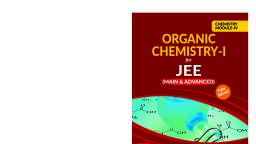Page 1 :
Chapter, Chapter, , 19, , Number, Organic, Systems, Chemistry, Remember, Before beginning this chapter, you should be able, to:, • �, have knowledge of elements, compounds and, mixtures., • �review the placement of elements in periodic table., , Key Ideas, After completing this chapter, you should be, able to:, • ��study the unique features of carbon., • �understand the classification of organic compounds., • �use the nomenclature of organic compounds., • �understand isomerism in organic compounds., • �, describe the preparation and properties of simple, alkanes, alkenes and alkynes., • �study about formation of coal and petroleum, isolation, of products of distillation of coal and petroleum., F I G U R E 1 . 1 Figure Caption
Page 2 :
9.2, , Chapter 9, , INTRODUCTION, Organic chemistry is the branch of science which touches almost every aspect of material civilisation, today. The age old classification of chemical compounds into two broad categories as organic and, inorganic compounds originated on the basis of the conception that they basically differ in their, source of origin. Inorganic compounds were supposed to take their origin from mineral kingdom, whereas organic compounds were believed to have their origin from plant and animal kingdoms., This concept leads to the assumption of vital force theory according to which the synthesis of, organic compounds could be carried out only in the presence of a mysterious vital force available in, living systems. The name ‘organic’ originated from this concept., The accidental synthesis of urea from an organic compound, ammonium cyanate was a major, breakthrough in the field of organic chemistry. A German scientist Fredrich Wohler prepared urea, a, component of human urine, by heating ammonium sulphate and potassium cyanate. Since then, the, development of organic chemistry has proceeded at a tremendous pace. With the advent of synthesis, of a large number of organic compounds, the definition of organic chemistry lost its significance., The modified definition of organic chemistry was stated as the chemistry of carbon compounds., This definition stemmed from the basic fact that all the compounds in living systems bearing water, invariably contain carbon. However, this definition was considered ambiguous because many, inorganic compounds like CO2, CaCO3, etc. containing carbon are available. Later on, the principal, characteristic of carbon compounds in living systems is that carbon is essentially associated with, hydrogen. This idea paved the way for the precise definition of organic chemistry as the chemistry, of hydrocarbons and their derivatives., Though the name ‘organic’ is slightly misleading in the context of the present status of chemistry,, the sharp line of distinction between inorganic and organic compounds continues to remain as, such till today. Nevertheless, in the present scenario, the special status of organic chemistry owes, not to the source of origin but to the remarkable properties exhibited by the compounds of carbon, which clearly distinguish them from compounds of the rest of the hundred odd elements in the, periodic table., , UNIQUE PROPERTIES OF CARBON COMPOUNDS, Organic compounds differ from inorganic compounds in most of the general properties., 1. N, � umber of compounds: The number of organic compounds is much more than that of, inorganic compounds. In fact, the organic compounds comprise about 90 per cent of all, known compounds., 2. C, � omposition of compounds: Composition of organic compounds is confined to very few, elements of the periodic table like carbon, oxygen, hydrogen, nitrogen, halogens and sulphur., In contrast to these, inorganic compounds are composed of almost all the elements in the, periodic table., �All these properties distinguish organic compounds from the inorganic compounds. In view of, these characteristics, the study of carbon compounds as a separate branch of organic chemistry, is justifiable. These properties of organic compounds are due to some special features possessed, by carbon., 1. T, � etravalency: Carbon atom has electronic arrangement of 2, 4 which represents the presence, of 4 electrons in the valence shell. It requires four more electrons to complete its octet., Therefore, carbon exhibits tetravalency.
Page 3 :
Organic Chemistry, , 2. C, � atenation: Carbon has a remarkable property of forming covalent bonds with other carbon, atoms, thus, forming long chains. This ability of forming long chains with atoms of the same, element is called catenation. Among all the elements, carbon shows maximum catenation, capacity due to the maximum strength of carbon–carbon bonds. This catenation property of, carbon accounts for the formation of innumerable number of compounds., C, , C, , C, , C, , C, , C, , C, , C, , C, , C, , C, , C, , C, , 3. F, � ormation of multiple bonds: Due to its small size, carbon can easily form multiple bonds, with carbon, oxygen, nitrogen, etc. This bond multiplicity is also responsible for the formation, of a wide variety of carbon compounds., Examples:, H, , H, , H, , C, , C, , H, , C, , H, , C, , H, , H, , O, , C, , C, , OH, , H, , H, , 4. I� somerism: The molecules of all organic compounds can be represented by two types of, formulae. They are discussed in the following:, (a) �Molecular formula: It indicates the actual number of atoms of various elements present, in one molecule of an organic compound. However, it does not give us any idea regarding, the type of bonds in the molecule., Example: C2H6, In one molecule of ethane, there are two carbon atoms and six hydrogen atoms., (b) �Structural formula: It gives the exact arrangement of the atoms of different elements, present in the molecule., Example:, , H, , H, , H, , C, , C, , H, , H, , H, , Ethane, , � In case of organic compounds, it is quite probable that two or more organic molecules, may possess the same molecular formulae but different structural formulae. That means the, molecules may differ in the structural arrangement of atoms. This phenomenon is called, isomerism., , CLASSIFICATION OF HYDROCARBONS, Hydrocarbons are a major class of organic compounds which contain only carbon and hydrogen as, the constituent elements., Hydrocarbons are broadly classified into two categories on the basis of the skeleton of carbon chain., , 9.3
Page 4 :
9.4, , Chapter 9, , 1. Aliphatic hydrocarbons or Open chain hydrocarbons, � he hydrocarbons which contain straight chain or branched chain of carbons are called, T, aliphatic hydrocarbons., Examples:, , H, , H, , H, , H, , C, , C, , C, , H, , H, , H, , H, H, , H, , H, , H, , C, , C, , C, , C, , H, , CH 2 H, , H, , H, , CH 3, Branched chain hydrocarbon, , Straight chain hydrocarbon, , �, , H, , �Aliphatic hydrocarbons are further classified as saturated and unsaturated hydrocarbons, based on the nature of carbon–carbon bonds present in the hydrocarbon molecules., , (a) �Saturated hydrocarbons: In the molecules of saturated hydrocarbons, all the valencies of, the carbon atoms are satisfied by single bonds. These are called alkanes. General formula of, this class of compounds is CnH2n + 2., Examples:, H, , H, , H, , H, , C, , C, , C, , H, , H, , H, , H, , H, , H, , H, , C, , C, , C, , C, , H, , H, , H, , H, , H, , H, , H, , Butane, , Propane, , (b) �Unsaturated hydrocarbons: The molecules of these hydrocarbons contain one or more, carbon-carbon multiple bonds. These are called unsaturated hydrocarbons. Based on the, type of multiple bond, unsaturated hydrocarbons are further classified into two categories, as discussed hereunder., �Alkenes: The unsaturated hydrocarbons which contain a carbon–carbon double bond in, their molecules are called alkenes. General formula of alkenes is CnH2n (assuming that one, double bond is present in the molecule), Examples:, HH, , HH HH, , HH, , CC==CC, , CC, , 1–Propene, 1–Propene, , HH, HH, , HH, , HH, , HH, , CC == CC, , HH, , Ethene, Ethene, , �Alkynes: These are unsaturated hydrocarbons which contain a carbon–carbon triple bond, in their molecules. General formula of alkynes is CnH2n–2 (assuming that one triple bond, is present in the molecule)., Examples:, H, H, , C, 1, , C, 2, , C, 3, , H, 1–Propyne, , H, , H, , C, , Ethyne, , C, , H
Page 5 :
Organic Chemistry, , 2. Closed chain hydrocarbons, � he class of hydrocarbons which possess closed chains of carbon skeleton are called closed, T, chain hydrocarbons. On the basis of chemical behaviour, they are further classified into two, types, i.e., alicyclic and aromatic hydrocarbons., (a) �Alicyclic hydrocarbons: These compounds resemble aliphatic hydrocarbons in their, chemical characteristics. They contain rings of three or more carbon atoms., H, , H, , H, , C, , C, , H, C, , H, , H, H, , H, C, , H, H, C, , H, , H, , C, , H, , Cyclopropane, , Cyclobutane, , C, H, , (b) �Aromatic hydrocarbons: This class of compounds also contain rings of carbon atoms but, differ widely from aliphatic hydrocarbon analogues in their chemical behaviour. They show, certain characteristic features which are not shown by aliphatic hydrocarbons. Benzene is, the simplest aromatic hydrocarbon. As a matter of fact, benzene is considered the parent, hydrocarbon for the entire class of aromatic compounds since all of them essentially possess, one or more benzene rings in their structures., H, C, , H, , H, C, , C, , C, , C, H, , C, , H, , H, Benzene, , NOMENCLATURE OF HYDROCARBONS, Nomenclature implies assigning proper names to the various compounds on the basis of certain, criteria. In case of organic compounds, two systems of nomenclature are in use which we now, discuss., 1. T, � rivial system: In the earlier period when vital force theory was in effect, the names of, organic compounds were given on the basis of the source of origin of the compounds. But, with the advancement of synthetic organic chemistry and discovery of enormous number of, organic compounds, this system of nomenclature lost its significance., 2. I� UPAC system: The need for a more systematic method of naming the organic compounds, resulted in framing certain rules for nomenclature of organic compounds by IUPAC., (a) �Longest chain rule: In the given structural formula, the longest possible carbon chain is, selected. This carbon chain is called parent carbon chain. Based on the number of carbon, atoms in the longest chain, a root word is assigned. The root word for the first four members, takes its origin from trivial names. For the other members, Greek numerals are used for, giving the root word., , 9.5
Page 6 :
9.6, , Chapter 9, , TABLE 9.1 Root words based on the number of carbon atoms in the longest chain, Number of carbon atoms, present in the longest chain, 1, 2, 3, 4, 5, 6, 7, 8, 9, 10, , Root word, Meth, Eth, Prop, But, Pent, Hex, Hept, Oct, Non, Dec, , Example:, C, , C, , C, , C, , C, , C, , C, , C, C, , Longest chain with seven carbon atoms., Root word corresponding to seven carbons—hept., (b) �Rule of primary suffix: The extent of saturation or unsaturation in the carbon chain is, indicated by primary suffix which is added to the root word., TABLE 9.2 Primary suffixes based on the nature of compounds, Nature of compounds, Saturated (all C−C bonds), Doubled bonded, Unsaturated (one C=C bond), Triple bonded, Unsaturated (one C≡C bond), , Primary suffixes, −ane, −ene, −yne, , �In case of unsaturated hydrocarbons, the parent carbon chain selected should include, multiple bonds., �It is also essential to mention the position of a multiple bond in the carbon chain. This is, done by numbering the carbon chain from one end to the other. The chain is numbered in, that direction in which the multiple bonded carbon gets the least number. The position of, multiple bonded carbon is mentioned before the root word., Examples:, H, , —, , H, , —, , H, , —, , H, , —, , H, , —, , —, , H, , —, , —, , —, , —, , —, , —, , H — 6C — 5C — 4C — 3C— 2C — 1C — H, H, , H, , H, , H, , H, , H, , Root word for 6 carbon chain—hex, Primary suffix—ane, Name—Hexane
Page 7 :
Organic Chemistry, H, , H, —, , —, , —, , H, , —, , H, , —, , H, , —, , —, , —, , —, , H— C — C— C — C=C, 5, 4, 3, 2, 1, H, , H, , H, , H, , Root word for five carbon chain—pent, Primary suffix—ene., Position of double bond−1, Name: 1−Pentene, H, , —, , —, , H, , H—C — C, , C — C —H, , —, , —, , 4, , 3, , 2, , 1, , H, , H, , Root word for four carbon chain–but, primary suffix is –yne, Position of triple bond−2, Name: 2−Butyne, (c) �Rules of substituents: A univalent group formed after the removal of one hydrogen atom, from alkane remains attached to the parent carbon chain. This univalent group is called, alkyl group., TABLE 9.3 Alkyl groups based on parent hydrocarbons, Parent hydrocarbons, CH4 (methane), C2H6 (ethane), C3H8 (propane), C4H10 (butane), , Alkyl groups (formula), –CH3, –C2H5, –C3H7, –C4H9, , Alkyl groups (name), methyl, ethyl, propyl, butyl, , I�n case of branched chain hydrocarbon, these alkyl groups which are linked to the parent, carbon chain are considered substituents. The prefix corresponding to the alkyl group is, added before the root word by mentioning the position number of the carbon in the main, chain which it is attached to. The carbon chain is numbered in that direction in which the, carbon linked to the substituent gets the least number., Examples:, H, |, , H, |, , H, |, , H, |, , H, |, , H, |, , H — C— C — C —C — C — C — H, 7, , |, H, , 6, , |, H, , 5, , |, H, , 4, , |, H, , |, , 3, , |, , CH2, , 2, , |, CH 3, , 1, , Root word—hept, Prefix—methyl, Position of the substituent—3, Name—3-methyl heptane, , 9.7
Page 8 :
Chapter 9, , Isomerism, When two or more substances have the same molecular formulae but differ in the structural, arrangement of atoms within the molecule, they are called isomers and the phenomenon is called, isomerism., Since the isomers differ in the structural arrangement of atoms, the phenomenon is called, structural isomerism. Depending on the type of variation in carbon chain, the structural isomerism, is of different types which we now discuss., , Chain Isomerism in Alkanes, Long chain alkanes differ in the arrangement of carbon atoms in the chain. Two or more molecules, may possess the same molecular formula, but they may differ in the arrangement of carbon atoms in, the chain. This type of isomerism exhibited by hydrocarbons is known as chain isomerism and the, molecules are called chain isomers. The straight chain isomer is called n-isomer. The isomer with a, single branch at a carbon atom is called an iso-isomer. The isomer with two branches on the same, carbon atom is called a neoisomer., Examples:, 1. Butane, Molecular formula: C4H10, Chain isomers of butane, (a), , H3C — H2C — CH2 — CH3, n–butane, CH3, , —, , (b), , H3C — CH — CH3, Isobutane, , 2. Pentane, Molecular formula: C5H12, Chain isomers of pentane, (a), , H3C — CH2 — CH2 — CH2 — CH3, n–pentane, , (b), , —, , CH3, H3C — CH2 — CH — CH2 — CH3, Isopentene, , (c), , —, , CH3, CH3 — C — CH3, —, , 9.8, , CH3, Neopentane, , Position isomerism, These isomers have same carbon chain with same number of branches but differ in the position of, multiple bond or substituent on the carbon chain.
Page 9 :
Organic Chemistry, , Example:, Pentene molecular formula: –C5H10, CH3 — CH2 — CH2 — CH = CH2 CH3 — CH = CH — CH2 — CH3, 1–Pentane, , 2–Pentane, —, , —, , C3H — CH — CH2 — CH2 — CH3 H3C — CH2 — CH — CH2 — CH3, CH3, , CH3, , 2–Methyl pentane, , 3–Methyl pentane, , Thus on rearranging the carbon atoms, different isomers are obtained. These isomers differ largely, in physical properties and to some extent in chemical properties. However, the compounds with, same constituent elements may possess different molecular formulae but have similar type of bonding, and hence show similar chemical properties. These compounds can be arranged into series which, gives rise to an idea of homologous series., , Functional Isomerism, Functional isomerism is the type of isomerism in which the isomers differ with respect to the nature, of functional group. Since the functional group is responsible for the chemical properties of organic, compounds, the compounds with different functional groups possess different chemical properties., , Homologous Series, A series of organic compounds in which each member differs from the next by a constant amount, when arranged in an increasing order of their molecular weights is called a homologous series., The adjacent members of this series differ by 14 in their molecular weights or –CH2 group, and, hence have a general formula. The members show a regular gradation in physical properties and, similar chemical properties. Thus, these can be prepared by similar methods., TABLE 9.4 Homologous series of alkanes (general formula CnH2n + 2), Molecular formulae, CH4, , Structural formulae, H, —, , IUPAC names of the alkane, Methane, , —, , H—C —H, , C2H6, , H, , H, —, , Ethane, , —, , H, , —, H, , H, , H, , H, , —, , —, , C3H8, , —, , Propane, , H, —, , H—C — C —H, , —, , —, , H, , H, , H, , H, , H, , H, , —, , —, , —, , C4H10, , —, , Butane, , H, —, , H—C — C — C —H, , —, , —, , —, , —, , H, , H, , H, , H, , H, , H, , —, , —, , —, , —, , —, , —, , —, , H—C — C — C —C —C —H, —, , C5H12, , H, , H, , —, , Pentane, , H, —, , H —C — C — C — C —H, , H, , H, , H, , H, , H, , 9.9
Page 13 :
Organic Chemistry, , Occurrence, It is available in the earth’s crust in the form of natural gas as it is the most volatile of all alkanes., Biogas or gobar gas also contains methane a the chief constituent., , Laboratory Preparation of Methane, Principle: In general, all alkanes can be prepared by the decarboxylation of sodium or, potassium salts of corresponding carboxylic acids. Carboxylic acids are a class of organic, compounds containing –COOH group where the hydrogen is acidic in nature and can, be replaced by sodium or potassium. The reagent used for decarboxylation is soda lime, (NaOH + CaO)., CaO, RCOONa + NaOH , , → R _ H + Na 2CO3, ( alkane ), , Methane can be prepared from the sodium salt of the carboxylic acid containing two carbon atoms., The carboxylic acid containing two carbon atoms is ethanoic acid or acetic acid (CH3COOH), and, its sodium salt is (CH3COONa), i.e., sodium acetate. This on treatment with sodalime (NaOH +, CaO) gives methane., Sodium acetate, + Soda lime, , Bunsen, burner, , Hard glass, test tube, , Methane, gas, Glass jar, , Iron stand, , Water, , FIGURE 9.1 Preparation of methane gas, , CH3COOH + NaOH+ → CH3COONa + H 2O, CaO, → CH4 + Na 2CO3, CH3COONa + NaOH + , , (m, methane), , Process, The mixture of sodium acetate and soda lime is heated in a hard glass test tube. Methane gas is, evolved and is collected by downward displacement of water., TABLE 9.7 Physical Properties of Methane, Parameters, Colour, Odour, Taste, Solubility, Vapour density, , Characteristics, Colourless, No characteristic smell, Tasteless, Insoluble in water and soluble in organic, solvents like CCl4, alcohol, 8 (lighter than air), , 9.13
Page 15 :
Organic Chemistry, , TABLE 9.9 Comparative study of ethene and ethyne, Parameters, Molecular formula, Structural formula, , Ethene, C2H4, H, H, , Trivial name, , Ethyne, C2H2, H—C≡C—H, , H, , C=C, , C, , Ethylene, , Acetylene, , Preparation Method of Ethene, Ethene can be prepared by cracking kerosene., , Cracking, Cracking is the process of breaking up of long chain hydrocarbons into smaller chain hydrocarbons, by heating at high temperature in the absence of oxygen. Basically, cracking is an important method, of preparing simpler alkanes and alkanes from higher alkanes. Cracking is of two types:, 1. T, � hermal cracking: The process involves heating the compound to a high temperature in the, absence of a catalyst., 2. Catalytic cracking: The process involves heating the compound in the presence of catalyst., Example: �Long chain alkane with six carbon atoms, i.e., hexane when subjected to cracking, gives butane, Heat, CH3 − CH 2 − CH 2 − CH 2 − CH 2 − CH3 , → H3C − CH 2 − CH 2 − CH3 + CH 2 = CH 2, , (Hexane), , (Butane), , (Ethene), , Laboratory Preparation of Ethene, In the laboratory ethene can be prepared by heating ethyl alcohol with excess of concentrated, sulphuric acid at 180°C. Apart from ethene, carbon dioxide and sulphur dioxide gases are evolved., These gases are removed by passing the gases over caustic soda. Finally, ethene gas is collected over, water by the down ward displacement of water., Thistle funnel, , Ethene gas, (Ethylene gas), , Ethanol + Conc., Sulphuric acid, , Water, , FIGURE 9.2 Preparation of ethene, 2 SO4, C2H5OH Con.H, , → C 2 H4 + H 2 O, 180° C, , 9.15
Page 16 :
9.16, , Chapter 9, , Laboratory Preparation of Ethyne, Ethyne can be prepared in the laboratory by taking a little amount of calcium carbide in a conical, flask to which a few drops of water are added. Ethyne gas is evolved and it is collected by downward, displacement of water:, CaC2 + 2H 2O → HC ≡ CH + Ca(OH )2, Ethyne, , Thistle funnel, Water, Pinch cock, , Ethyne, , Calcium, carbide, +, Water, , FIGURE 9.3 Preparation of ethyne, , TABLE 9.10 Comparative study of ethene and ethyne, Physical properties, Ethene, Colourless, tasteless gas, Peculiar odour, Insoluble in water, Soluble in non-polar solvents, Vapour density 14, Slightly lighter than air, , Ethyne, Colourless, tasteless gas, Characteristic garlic odour, Insoluble in water, Soluble in non-polar solvents, Vapour density 13, Slightly lighter than air, , Chemical Properties, (i) Combustion, Burns with a pale blue, sooty flame in excess, Burns in excess of air with evolution of large amounts, of air, of CO2, , C2H4 + 3O2 , → 2CO2 + 2H 2O, air, , Excess, 2C2H 2 = 5O2 , → 4CO2 + 2H 2O, Air
Page 17 :
Organic Chemistry, Chemical Properties, Ethene, , Ethyne, , (ii) Hydrogenation, When equal volumes of ethane gas and, hydrogen is passed over heated nickel or, platinum at 300°C, one molecule of hydrogen, is added, , When a mixture of ethyne and hydrogen in 1 : 2 ratio, is passed over heated nickel at 300°C, two molecules of, hydrogen get added. Product may be ethene or ethane, , H, H – C = C – H + H2, , Ni, , H, , H, H, , H, , C, , C, , 300°C, H, , H H, Ethene, , C, , C, , H + H2, , Ethyne, , Ni, , H, , C=C, , H, , Ethene, Ni, , 300°C, , H, , Ethane, H, , (iii) Addition of bromine, Decolourisation of bromine water takes place, when ethene gas is passed through bromine, water and one molecule of bromine is added, , H, , H, , C=C, , H + Br2, , H, , H, , H, , C, , C, , H, , C C, |, |, H H, Ethane, , H, , H, , H+H 2, , 300 °C, , H, , Decolourisation of bromine water takes place when, ethyne gas is passed through bromine water as two, molecules of bromine get added, Br Br, , H, , H, , Br Br, 1,2 – Dibromoethane, H, , C, , C, , H, , H, , C=C, , H + Br2, H C=C H, 1,2 Dibromoethene, Br Br, H + Br2, , H, , C, , C, , H, , Br Br, 1,1,2,2 – Tetabromoethene, , (iv) Polymerisation, A number of ethene molecules add to each, other at high temperature forming long chains, called polythene, , nH 2C = CH 2 → (CH 2 − CH 2 )n, , Three molecules of ethyne add to each other forming, benzene, 300° C, 3HC ≡ CH Red, , , → C6 H6, hot, Cu tube, , Applications of Chemical Properties, 1. H, � ydrogenation of unsaturated hydrocarbons: This reaction is made use of in the, hydrogenation of vegetable oils. Some vegetable oils containing unsaturation, when subjected, to hydrogenation in the presence of a nickel catalyst at 473 K and 5 atm pressure, get solidified, and produce vanaspathi ghee., Ni, Vegetable oils + H2 473, , → vanaspathi ghee, K,5 atm, , Examples: Groundnut oil, mustard oil, cotton seed oil, etc., , 9.17
Page 18 :
9.18, , Chapter 9, , 2. D, � ecolourisation of bromine water: This reaction is used for testing the unsaturation in, organic compounds., TABLE 9.11 Uses of hydrocarbons, Compounds, Methane, , Ethene, , Ethyne, , Useful product, Natural gas, Bio gas, Derivatives, Polythene, Ethene gas, Oxy acetylene, Acetylene, , Use, Automobile fuel, fertiliser synthesis, Domestic fuel, Synthesis of useful industrial products, Manufacture of plastics, Artificial ripening of fruits, preparation of thiokol, and glycol, Welding metals, Illumination, ripening of fruits, , EXAMPLE, Methane is considered as a more environment friendly fuel than petrol. Justify., SOLUTION, Methane on combustion produces the least amount of CO2 among all hydrocarbons. Petrol, contains hydrocarbons ranging from C5 to C10. These hydrocarbons produce more amount, of CO2 than methane on combustion. Moreover, the knocking increases with the length of, carbon chains. Petrol can show more knocking property which reduces the fuel efficiency, and requires more amount of fuel per release of unit energy. Due to these reasons, methane is, considered as more environment friendly fuel than petrol. CO2 being a greenhouse gas causes, global warming., , EXAMPLE, Two containers A and B are filled with the same amount of chlorine gas. Limited amount of, methane is passed into container ‘A’ and excess of methane into container ‘B’. Identify the, products formed in A and B. Give reason in support of your answer., SOLUTION, If limited amount of methane is passed through the container ‘A’ methyl chloride is formed, first. As the amount of methyl chloride increases, it competes with methane for the available, chlorine. Once the concentration of methyl chloride exceeds the concentration of methane,, chlorine attacks on methyl chloride rather than methane, forming methylene chloride which in, similar way gets chlorinated finally forming CCl4., The end product is a mixture of methane, methyl chloride, methylene chloride, trichloromethane, and carbon tetrachloride.
Page 19 :
Organic Chemistry, , In second case if excess of methane is passed, only methyl chloride is formed., CH4 + Cl2, Methane, + Chlorine, , –HCl, , CH3Cl, , Cl2, –HCl, , Methyl, chloride, , CH2Cl2, Methylene, chloride, , Cl2, –HCl, , CHCl3, Trichloro, methane, , –HCl, , Cl2, , CCl4, Carbon, tetrachloride, , CH4 + Cl2 ® HCl + CH3Cl, (excess), Methyl chloride, , EXAMPLE, A more hydrogenated oil is less rancid than less hydrogenated oil. Give reasons., SOLUTION, Rancidity of oils is due to the presence of acids and some other organic compounds. These, compounds are formed by the attack of oxygen on the double bonds of unsaturated oils. In the, hydrogenated oil, the unsaturation positions are converted to saturated positions. As a result,, oxidation of double bonds is prevented., , Hydrocarbons, thus, in most cases are useful for the generation of energy. Some of them are, available naturally. There are also other natural resources of energy which are widely used., , NATURAL SOURCES OF ENERGY, Energy is the primary requirement for the existence of life on earth. Solar energy, hydel energy, and wind energy are some sources of energy which are inexhaustible. This is because they can be, generated continuously and can replace the used up energy from time to time. They are, therefore,, called renewable sources of energy. On the other hand, there are some energy sources which get, exhausted over a period of time as they can not be replenished from time to time so easily. Coal, and petroleum are two major non-renewable sources of energy. These are organic matter and are, formed by the degradation of dead plants and animals., , Formation, Millions of years ago, the dead plants and animals were buried beneath the surface of earth. Owing, to the high temperature and pressure existing in the bottom most strata of earth’s crust, the organic, matter in the remains of plants got converted to coal while small marine animals and plants got, converted into petroleum. Hence, these are called fossil fuels. As this is a very slow process and, takes millions of years, coal and petroleum are known as non-renewable sources of energy., Coal and petroleum are complex mixtures of hydrocarbons. Hydrocarbons being combustible,, coal and petroleum also undergo combustion producing large amounts of energy. Therefore, they, act as sources of energy. These two are not only the major reservoirs of energy which meet 90 per, cent of the energy requirements of the world, but also the main sources for the synthesis of many, useful organic chemicals., , 9.19
Page 20 :
9.20, , Chapter 9, , Coal, Composition of coal: Coal is mainly composed of carbon and also some hydrocarbons. In addition, to these, coal contains some inorganic compounds of nitrogen, oxygen and sulphur., Different varieties of coal which differ in the percentage of carbon are available., TABLE 9.12 Varieties of coal, Variety of coal, Anthracite, Bituminous, Lignite, Peat, , Percentage of carbon, 90 per cent, 70 per cent, 40 per cent, 10−15 per cent, , Extraction of coal: The technique used for the extraction of coal from mines depends upon the, mode of occurrence of coal in the earth’s crust. Coal, when present in the upper layers, is extracted, by open cast mining technology. Coal available in the deeper layers of earth’s crust can be extracted, by using underground mining technology., Destructive distillation of coal: When coal is subjected to heating at high temperatures up to, 1300−1700 K in the absence of air, a number of volatile products are obtained along with a nonvolatile residue called coke. The process of heating of coal in the absence of air is called destructive, distillation or carbonisation: The volatile products are mainly composed of three components,, namely, coal gas, ammonia and coal tar., Isolation of products: The volatile products are first passed through water. Ammonia gets dissolved in, water and is removed. Coal tar being insoluble in water, settles down as an oily liquid. Coal gas which, is also insoluble in water escapes out. It consists mainly of methane, carbonmonoxide and hydrogen., , Fractional Distillation of Coal Tar, Coal tar, a black viscous liquid, when subjected to fractional distillation gives different products., These products on further distillation give various aromatic compounds like benzene. These, compounds are the parent compounds used in the preparation of various industrially useful products, such as dyes, drugs, polymers, pesticides, etc., TABLE 9.13 Fractional distillation of coal tar, Main fraction, Light oil, Middle oil, Heavy oil, Green oil, Residue, , Boiling point range (°C), 80–170, 170–230, 230–270, 270–400, Above 400, , Composition, Benzene, Phenol, naphthalene, Phenol, naphthalene, anthracene, Anthracene, Pitch, , Petroleum: It is a dark viscous oily liquid generally known as rock oil or crude oil. The word, petroleum originated from Greek words petra—meaning rock and oleum—meaning oil., Composition of petroleum: The precise composition of petroleum cannot be specified since, it depends on the place of origin. Nevertheless, petroleum can be considered a complex mixture, of hydrocarbons, composed predominantly of alkanes and cycloalkanes. Some petroleum deposits, also contain reasonable amounts of aromatic hydrocarbons and alkenes. Trace amounts of oxygen,, nitrogen and sulphur are also present since it is obtained from the remains of dead plants and animals.
Page 21 :
Organic Chemistry, , Extraction of petroleum: Under earth’s surface, petroleum deposits are found to be, associated with a layer of natural gas. These can be drawn out by drilling deep wells through, the various layers of earth till the oil-bearing strata are reached. Due to the process of drilling,, pressure is developed in those layers. Consequently, the gases are fizzed out of the solution and, the crude oil is gushed out., As the oil drawn out by this method is only 20 per cent, water or compressed air is pumped, through the outer pipe and oil is drawn out through the inner pipe. By this way, it is possible to draw, greater proportion of petroleum., Gases, , Gasoline, Kerosene, Diesel oil, Lubricating, oil, , Crude, oil, , Steam, Non-volatile, fraction, , FIGURE 9.4 Fractionating Tower, , Processing of petroleum: Since the crude oil is drilled out from earth’s crust, it obviously, consists of lots of impurities. In addition to this, petroleum being a complex mixture of various, hydrocarbons, it is necessary to separate the components. The process of removal of undesirable, impurities followed by the separation into different useful fractions is called refining of, petroleum., Refining of petroleum: The basic principle involved in refining petroleum is fractional, distillation of the crude oil over a specific range of temperature as the different hydrocarbons have, different boiling points. The refining is carried out in a fractionating tower. The fractionating tower, is a tall cylindrical tower made up of a number of horizontal stainless steel troughs., The crude oil which is free from impurities is fed at the base of the fractionating tower at 675 K., At this temperature, all the volatile components vaporise and pass through the fractionating tower., As the vapour is passed through this column, they get condensed at different heights of the tower., The components which have higher boiling points get condensed first and the components having, lower boiling points are carried to the top. Thus, the various fractions formed by condensation are, collected in different trays separately. The non-volatile part of the crude oil remains in the tower in, the form of a solid residue called asphalt., Before subjecting crude oil to fractional distillation, it should be freed from inorganic impurities., This is done by passing the raw crude oil between highly charged electrodes which remove all water, from the sample. It is, then, treated with copper oxide to remove the sulphur compounds., , 9.21
Page 22 :
9.22, , Chapter 9, , TABLE 9.14 Useful fractions obtained after refining of petroleum, Main fraction, Petroleum gas, Crude naphtha, , Boiling temperature, range, Below 30°C, 30–150°C, , Kerosene Oil, , 150–300°C, , Fuel oil, , 300–350°C, , Lubricating oil, Paraffin wax, , 350–400°C, Above 400°C, , Composition, C1–C4, (i) �, Petroleum ether, (below 90°C) (C5–C7), (ii) �Petrol, (90–120 °C) (C7–C9), (iii) �Benzene, (120°C–150°C) (C9 – C10), C10–C16, C16–C20, (i) Gas oil, (ii) Diesel oil, (iii) Furnace oil, C20–C24, C24 and above, , Uses, Fuel, for making carbon black, Solvent, Motor fuel, Dry cleaning, , Cooking fuel illuminant, oil gas, Motor fuel, cracking stock, for petrol., , Paint oil, lubricants, Candles, matches, paints,, water proofing, ointments,, protective paints., , Important Fuels Obtained from Petroleum, The various components obtained by the process of fractional distillation of petroleum contains, mixtures of hydrocarbons having different lengths of carbon chains. These fractions are used as fuels, for different purposes after further purification. Purification makes the fuels devoid of corrosive, constituents and unpleasant odours., 1. �Natural gas: Since all petroleum deposits are associated with natural gas, extraction of petroleum, inevitably involves the collection of natural gas. Natural gas is composed of highly volatile, alkanes, predominantly methane. Consequently, it undergoes rapid combustion releasing large, amounts of heat., Natural gas has a wide range of applications in domestic and industrial activities., (a) �Compressed natural gas can be used as an automobile fuel, i.e., as a substitute for petrol and, diesel. It shows greater fuel efficiency and is available at a lower cost., (b) �Natural gas can also be used as a domestic fuel., (c) �Natural gas can be used as a raw material for the manufacture of carbon black and hydrogen., The hydrogen so obtained can be used in the synthesis of ammonia which is the most, important component of nitrogenous fertilisers., K, CH4 + H2O 1100, , → CO + 3H2 + 11.7 kJ, high temperature, , and pressure, N 2 + 3H2 , → 2NH3, Fe + Mo, , 2. �Petroleum gas: This is the most important by-product of petroleum processing. The major, proportion of petroleum gas is n-butane, the minor components being ethane and propane., Petroleum gas, when subjected to high pressure, can easily pass into liquid state. This easy, liquefaction of petroleum gas renders it a very useful domestic fuel in the form of LPG (liquefied, petroleum gas).
Page 23 :
Organic Chemistry, , LPG: It has a high calorific value and burns in air with a blue non-luminous flame. It is, associated with very low ignition temperature and can be lighted easily. This, being a colourless, and odourless gas, is mixed with small amounts of ethyl mercaptan which imparts a characteristic, unpleasant odour to LPG, thus, rendering easy detection of leakages., 3. �Petrol: The most important product of petroleum processing is petrol or gasoline which is, used as a fuel for automobiles. In addition to this, it is also used for dry cleaning of clothes., Coal and petroleum have wide range of applications both in industry and day-to-day life. All, the applications are based on the same principle of combustibility of hydrocarbons. Combustion, being a highly exothermic process, the heat energy can be either directly used or can be trapped, and converted to another form of energy and used. The domestic fuels like LPG, kerosene and, biogas are important products of petroleum industry. Coal forms the most important fuel for, the generation of electricity in thermal power plants., , SOME IMPORTANT APPLICATIONS OF ORGANIC CHEMISTRY, Chemistry has a very important role to play in our daily life and it is more so with organic chemistry., The food we consume, the cosmetics we use, the drugs we use for treating various diseases etc.,, are all made up of organic compounds. Therefore, it is not an exaggeration to claim that organic, chemistry intrudes into each and every aspect of our day-to-day life., , Use of Organic Compounds as Ingredients of Food, It is a well-known fact that the food is made up of complex organic compounds such as carbohydrates,, proteins, oils, fats, vitamins, etc. These are all quite essential for growth and maintenance of our, body. In addition to these, there are other ingredients of food which are consumed in relatively lesser, proportions. They include food preservatives and food colours. Food preservatives are chemical, substances added to packed food items for the purpose of preventing spoilage of food material over, a long period of usage., TABLE 9.15 Food preservatives and their fromulae, Names, Acetic acid (vinegar), Sodium benzoate, , Formulae, CH3 COOH, C6H5COONa, , Flavouring agents: These are chemical substances added in minor proportions which enhance the, flavour and taste of the food materials., Examples:, , TABLE 9.16 Flavouring agents and their structures, , Names, Monosodium, glutamate (MSG), Esters of carboxylic acids, , Structures, COONa, H2N – (CH2)2 C, COOH, RCOOR1, , Citric acid or sodium, citrate (soft drinks), , ds, , CH2 –– COOH, CH –– COOH, , CH2 –– COOH, , Certain chemical substances can be added to food items which impart colour to them., , 9.23
Page 24 :
9.24, , Chapter 9, , TABLE 9.17 Examples of food colours, Names, Tartrazine, Erithrocine, Indigo, , Colours, Yellow, Red, Carmine (blue), , Apart from all these, certain ingredients like caffein (alkaloid) are added to chocolates and soft, drinks which act as stimulants to central nervous system., , Other Ingredients, Caffeine (alkaloid): It is generally added to soft drinks and chocolates. It acts as a stimulant to, central nervous system., Citric acid or sodium citrate: Used as a flavouring agent in soft drinks., All these ingredients do not constitute essential part of our food. Since these substance have little, or no nutritional value and their intake causes more harm to the body, the consumption of these, substances should be either avoided or minimised., Just like in food materials, the role of chemicals in cleaning is also inevitable. Soaps and detergents, are the most common commodities used for the purpose of cleaning., , Use of Organic Compounds in Soaps and Detergents, Soap is the sodium or potassium salt of higher fatty acids. Fatty acids are a class of organic compounds,, which show characteristic acidic properties. Since fatty acids are the major constituents of vegetable, oils, soaps are prepared by the hydrolysis of these oils in presence of an alkali like NaOH or KOH., The most commonly used oils are coconut oil, palm oil, cotton seed oil, ground nut oil, etc., Detergents are also used for the same purpose and possess similar structure except that detergents, are sodium or potassium salts of benzene sulphonic acids. These acids are generally available or made, from petroleum products., , Structure and Composition of Soaps and Detergents, Soap molecule is made up of a long chain of hydrocarbons attached to carboxylate group which, constitutes anionic part of the molecule and positive part of Na+ and K+., C17H35COONa → C17H35COO–Na+, Similarly a detergent molecule is composed of a long chain of hydrocarbons containing benzene, ring attached to sulphonate group which constitutes the anionic part., O–, , ONa, C12H25, , S, , O, , C12H25, , O, , Examples:, Soap ⇒ Sodium or potassium salt of stearic acid, C17H35COONa, , S, O, , O + Na+
Page 25 :
Organic Chemistry, , Detergent ⇒ Sodium laurate, ONa, S, , C12H25, , O, , O, , Cleansing Action of Soaps and Detergents, Generally, dirt is found to stick to the surface by means of an oily substance. Since oil and water are, not miscible with each other, water cannot remove the dirt. When soap is dissolved in water, firstly, it reduces the surface tension of water, thereby increasing the area of contact between water and dirt., Secondly, soap gets ionised into an anionic radical such as stearate radical and Na+ or K+ as cationic, radical. The anionic radical consists of a hydrocarbon chain which is hydrophobic and a hydrophilic, carboxylic acid as head. The hydrophilic end dissolves in water and the hydrophobic end mixes with, the oil. Thus, soap forms a link between oil and water thereby separating the dirt which forms an, emulsion with water and is removed off., +, Na, O, , +, O, , Polar head, , C, , +, , –, , –, , –, , –, , –, , Non-polar ‘tail’, , –, +, , (a), , +, , –, , –, +, , +, , –, , –, , –, , –, , –, , Na+ions, , +, , –, , –, +, , +, , +, , +, , –, +, , +, (b), , FIGURE 9.5 (a) A soap molecule and (b) Cross-section of a soap micelle in water, , The detergents are also similar in structure and action to soaps. The basic difference between the, soap and the detergent is that soap forms insoluble calcium and magnesium stearates on dissolution in, hard water. On the other hand, detergents produce soluble calcium and magnesium sulphonates on, dissolution in hard water. Therefore, detergents are more efficient with hard water when compared, to soaps. However, detergents have a disadvantage of causing environmental pollution over soaps., , Types of Soaps, In addition to the sodium stearate which is the main ingredient, different types of soaps contain, different additional ingredients which impart required quality to soaps., TABLE 9.18 Types of soaps and their chemical composition, Type of soap, Washing soap, Toilet soap, , Baby soap, Transparent soap, , Chemical composition, Washing soda in place of caustic soda, Caustic soda (for harder soaps), Caustic potash (for soft soaps), Mixture of oils and fats, Olive oil as additional ingredient, Glycerine and castor oil, , With the tremendous industrial and technological development of society, hydrocarbons and, their derivatives continue to have more and more significant applications. Petroleum is the most, important raw material for the manufacture of hydrocarbons. Therefore, it is a high time to realise, , 9.25
Page 26 :
9.26, , Chapter 9, , that the rational and judicious use of exhaustible natural resources can go a long way in achieving, sustainable development coupled with conservation of environment., EXAMPLE, LPG contains butane and propane in major proportions whereas CNG contains methane as the, major component. Justify., SOLUTION, Both butane and propane can be liquefied relatively under moderate pressure and these liquefied, forms readily vapourise under normal conditions. Moreover, the calorific value is high and almost, equal in both cases. Easy liquefication of these gases permits easy transport and storage. Natural, gas is associated with petroleum deposits. It contains methane as major component since it is the, hydrocarbon having minimum boiling point and the most volatile. Petroleum being the mixture, of hydrocarbons, methane volatilises and escapes out forming a layer of natural gas., , EXAMPLE, Some fractions of petroleum refining are used as dry cleaning liquids and some fractions are used, as lubricating oils. What are the requisite characteristics of those fractions?, SOLUTION, The easily vapourisable fractions obtained from petroleum refining are used as dry cleaning liquids, due to their volatile nature. The fractions which have higher boiling points are used as lubricating, oils due to their high thermal resistance., , EXAMPLE, What is the composition of petroleum gas? Why is it used as a domestic fuel?, SOLUTION, Petroleum gas contains hydrocarbons with 1 – 4 carbon atoms. It is used as a domestic fuel due to, its high calorific value and also because of its easy liquefaction.
Page 27 :
Organic Chemistry, , 9.27, , TEST YOUR CONCEPTS, Very Short Answer Type Questions, , carbon compounds?, , 16. What is meant by decarboxylation? How can methane be prepared by using this reaction?, , 2. Name the first organic compound synthesised and, mention how it was synthesised., , 17. Why is natural gas composed of major proportion of, methane?, , 3. State the modern definition of organic chemistry, and justify., , 18. Cyclohexane, hydrocarbon., , 4. Unsaturated hydrocarbons give their characteristic, , 19. On what basis is coal classified into different varieties?, , _______ reactions., , is, , an, , example, , for, , ________, , 20. How is ammonia manufactured from natural gas?, , 5. Define catenation. What is its special significance, with respect to organic chemistry?, , 21. Give the IUPAC names for the following, hydrocarbons., , 6. Give general formulae for alkanes, alkenes and, alkynes., , , (a), , 7. What are aliphatic hydrocarbons? How are they, classified?, 8. The structure of isobutane is ______., 9. What is primary suffix in the name of an organic, compound?, 10. Why are coal and petroleum called fossil fuels?, 11. What are the techniques available for the extraction, of coal from coal mines?, 12. What is the principle involved in the refining of, crude oil?, 13. Calcium carbide, on hydrolysis, gives ______., 14. What are natural gas and petroleum gas?, 15. What is meant by destructive distillation? What are, the products of destructive distillation of coal?, , H3C, , CH2, , CH, , CH3, , CH3, CH3, , , (b), , H3C, , CH2, , CH, , CH, , CH3, , 22. Mention some uses of methane., 23. Detergents are sodium salts of ________., 24. Write the position isomer for butyne., 25. How is acetylene prepared from calcium carbide?, Give equation., 26. What is the chemical reaction associated with the, hydrogenation of oils?, 27. What are soaps? How are detergents different from, soaps in chemical composition?, 28. __________ is the additive added to soap to make it, transparent., 29. ________end of soap dissolves in soft water., 30. What are food preservatives? Give two examples., , Short Answer Type Questions, 31. What is meant by homologous series? What are its, characteristics?, 32. List out the characteristic properties of carbon, compounds., , 33. Define cracking. Explain the types of cracking., 34. Why are coal and petroleum considered non-, renewable sources of energy?, 35. Explain the process of refining crude oil., , PRACTICE QUESTIONS, , 1. Why was organic chemistry considered chemistry of
Page 28 :
9.28, , Chapter 9, , 36. Explain the composition of petroleum., , 40. Explain isomerism in alkanes., , 37. By giving equations, explain the Decolourisation of, bromine water by unsaturated hydrocarbons., , 41. Explain the laboratory preparation of ethylene., , 38. Explain hydrogenation of ethene and ethyne., 39. Give the structural formulae of the first four members of homologous series of alkanes, alkenes and, alkynes., , 42. How can CNG be a better alternative to petrol?, 43. Explain the advantages of detergents over soaps., 44. Explain the various ingredients added to food items, by giving examples., , Essay Type Questions, 45. Explain the unique features of carbon., 46. Discuss in detail the important products of petroleum processing. Give an account of their uses., 47. Explain the extraction and processing of coal., , 48. Give the chemical properties of methane, ethane, and ethyne. Give equations., 49. Explain in detail the cleansing action of soaps and, detergents., , CONCEPT APPLICATION, Level 1, Direction for questions from 1 to 7:, State whether the following statements are true, or false., , PRACTICE QUESTIONS, , 1. Each homologous series is characterised by a general formula., 2. Pentane has three chain isomers., 3. All saturated hydrocarbons are aliphatic hydrocarbons., 4. Methane can be prepared by the decarboxylation of, sodium methanoate., , 10. 1-butene and 2-butene are ________isomers., 11. Ethane can be prepared by decarboxylation of, ______., 12. The method involved in refining of petroleum is, ________., 13. Hexane, on cracking, gives ______ and ______., 14. The best quality coal with respect to percentage of, carbon is _______., , 5. Hydrogenation reaction can be used to detect, unsaturation in an organic compound., , Direction for question 15:, Match the entries in Column A with the, appropriate ones in Column B., , 6. Ethyne on Polymerisation gives benzene., , 15., , 7. Hexyne can decolourise bromine water., Direction for questions from 8 to 14:, Fill in the blanks., 8. Closed chain hydrocarbons which do not resemble, aliphatic hydrocarbons in their chemical behaviour, are called ________., 9. IUPAC name of saturated straight chain hydrocarbon with 10 carbon atoms is ______., , A., B., C., D., , Column A, Natural gas, Coke, Cn H2n, Kerosene, , E., F., , C6H6, Polythene, , (, (, (, (, , ), ), ), ), , ( ), ( ), , Column B, a. Polymerisation of ethene, b. Benzene, c. Methane, d. Destructive distillation of, coal, e. Refining of petroleum, f. Alkene
Page 30 :
9.30, , Chapter 9, , 29. Which of the following structures does not correspond to the chain isomer of pentane?, CH3, , (a), , H3C, , CH2, , C, , 34. Which among the following molecular formulae, represents a saturated hydrocarbon?, (a) C4H8, (b) C4H6, (c) C3H4, (d) C5H12, , CH3, , H, CH3, , (b), , H3C, , C, , 35. Which among the following pairs belong to the, same homologous series?, (a) C3H4, C5H10, (b) C2H6, C4H8, (c) C2H4, C4H6, (d) C4H8, C5H10, , CH3, , CH3, , (c), , H3C, , CH3, , CH3, , CH, , CH, , 36. The number of bromine molecules required for the, Decolourisation of 1 mole of ethene and ethyne are, respectively, (a) one and three, (b) two and three, (c) one and two, (d) two and four, , CH3, , CH3, , (d), , H3C, , CH, , CH2, , CH3, , 30. Which of the following is not an alkene?, (a) C4H8, (b) C4H6, (c) C3H6, (d) C5H10, , 37. Polymerisation of ethyne at 300°C gives, (a) polyethene, (b) polyethyne, (c) benzene, (d) polyvinyl chloride, , 31. IUPAC name of a hydrocarbon is given as 3,, 5-Dimethyl-2-hexene. Identify the correct sequence, of steps to draw its structural formula., , 38. The bromination of acetylene gives _________ as, the final product., (a) dibromoethane, (b) tetrabromoethane, (c) tetrabromoethene, (d) dibromoethene., , , (1) numbering of carbon chain, , (2) locating the position of double bond, , (3) �writing long chain corresponding to hexane, , PRACTICE QUESTIONS, , (c) �2 moles of carbon dioxide and 1 mole of water, (d) �2 moles of carbon dioxide and 2 moles of water, , , (4) �, locating the methyl groups (prefixes) at the, respective positions, , (5) �, placing hydrogens to satisfy tetravalency of, carbon, (a) 13254, (b) 32145, (c) 13245, (d) 31245, 32. Identify the correct sequence of fractions obtained, when petroleum is subjected to fractional, distillation., , (1) lubricating oil , , (2) petrol, , , (3) petroleum ether , (a) 2341 , (c) 3214 , , (4) diesel oil, (b) 3241, (d) 2431, , 33. 1 mole of ethyne on complete combustion gives, (a) �2 moles of carbon monoxide and half-mole of, water, (b) �4 moles of carbon dioxide and 1 mole of water, , 39. Which of the following is an identification test for, unsaturation in an organic compound?, (a) addition of hydrogen, (b) addition of ozone, (c) addition of bromine, (d) addition of oxygen, 40. The hydrocarbon used for welding purpose is, (a) ethane, (b) ethyne, (c) ethene, (d) benzene, 41. Coal gas mainly consists of, (a) methane, CO, H2, (b) propane, CO2, H2, (c) methane, CO, H2O, (d) methane, CO2, H2, 42. The reagent NaOH + CaO is used for, (a) carboxylation, (b) dehydrogenation, (c) hydrogenation, (d) decarboxylation
Page 31 :
Organic Chemistry, , 43. Degradation of organic wastes in the absence of air, gives, (a) methane, (b) methane, hydrogen, nitrogen and CO2, (c) �methane, carbon monoxide and hydrogen, (d) methane, SO2 and hydrogen, 44. Sulphur compounds in crude oil can be removed by, using, (a) copper oxide, (b) alumina, , 9.31, , (c) iron oxide, (d) magnesium oxide, 45. Petroleum fraction of which of the following compositions can be used as a lubricating oil?, (a) C5–C7, (b) C10–C16, (c) C20–C24, (d) C30–C40, , Level 2, , 2. Give IUPAC names for the following:, (a), , H3C, , CH, , CH2, , CH = CH2, , CH3, CH3, , (b), , HC, , CH2, , CH3, , CH3, C2H5, , (c), , HC ≡ C, , C, , CH3, , H, CH3, , (d), , H3C, , CH = CH, , CH, , CH3, , 3. A hydrocarbon ‘X’ can have only three chain isomers, and one of the isomers consists of same alkyl groups, attached to central carbon atom with single bonds., Identify the preceding and succeeding homologue, of ‘X’., 4. Explain the role of natural gas in the preparation of, ammonium fertilisers., 5. A straight chain saturated hydrocarbon with vapour, density 43 on heating in absence of air gives X and, Y.Y on treatment with bromine water gives Z., Identify X, Y and Z., 6. The percentage composition of a hydrocarbon ‘X’, is 90 per cent carbon and 10 per cent hydrogen,, respectively. Write the structural formulae of two, successive and preceding homologues of X., 7. Why are some coal deposits associated with large, amounts of sulphur?, , 8. Give the structural formulae of four compounds of, the homologous series succeeding the one having, molecular formula C3H4. Also give their molecular, weights., 9. Compound X can be prepared by passing a gas Y, through a metal tube which is at very high temperature. Y on treatment with 2 g of hydrogen gas in, presence of nickel gives a compound Z. Z can also, be prepared by treating ethyl alcohol with ‘ic’ acid of, sulphur at 170°C. Y can also be prepared by hydrolysis of ‘A’. Identify X, Y, Z and A and write all the, balanced chemical equations., 10. Two containers A and B are filled with the same, amount of chlorine gas. Limited amount of methane, is passed into container ‘A’ and excess of methane, into container ‘B’. Identify the products formed in, A and B. Give a reason in support of your answer., 11. The vapour density of an unsaturated aliphatic, hydrocarbon ‘X’ is 34. Write the structural formula, of X and its succeeding homologue Y. Also write, the position isomers of X and Y., 12. How does the burning of coal lead to air pollution as, well as water pollution?, 13. At the end of the process of preparation of soap,, common salt is added. Explain the role of common, salt in that process., 14. A compound X on hydrolysis produces a gas Y which, on hydrogenation produces a gas Z which can decolourise bromine water forming a compound with, molecular weight 188 a.m.u. Identify X, Y and Z., 15. Two students Rishi and Kushi were preparing for, International Chemistry Olympiad. They had come, , PRACTICE QUESTIONS, , 1. Write all possible chain isomers for pentene and, hexyne.
Page 32 :
Chapter 9, , PRACTICE QUESTIONS, , 18. The molar ratio of carbon dioxide and water produced by the combustion of one mole of an aliphatic hydrocarbon ‘X’ is 5 : 4. Write the possible, structures of X. What happens when ‘X’ is passed, through bromine water?, 19. The government had a proposal for establishing, a thermal power plant where coal would be the, source of power. A panel has been sent to the site, to examine the feasibility of the proposal. The farmers in that area became panicky that their soils may, become less fertile and may even become unfit for, cultivation. However, the panel members convinced, them by giving an assurance that the best quality coal, will be used in the plant to minizise the effect. Can, you explain the reason why burning of coal makes, the soil loses fertility and how quality of coal has a, bearing on the above? What other effects does burning of coal have on the environment?, 20. CNG is a better automobile fuel when compared to, petrol and diesel. Give reasons., , —, —, , H3C – CH – C – CH3, —, , (a), , OH, , CH3, —, , Cl, H3C – CH – CH2 – CH – CH3, , (c), , CH3 – CH – C = CH – CH3, , (d), , H3C – CH – CH2 – CH = CH2, , —, , (b), , —, , —, , COOH, , CH3 CH3, , CH3, C2H5, , CH3, , —, , (f), , H3C – C – CH3, , HC ≡ C – CH3, —, , (e), , CH3, , H, CH3, , (g), , —, , 17. A research scholar, during his experiment came, across an aliphatic hydrocarbon ‘X’. In the process, of identification of ‘X’ he passed ‘X’ through alkaline KMnO4. The solution became colourless. He, found out the vapour density of the compound to, be 34. Identify X and its succeeding homologue, ‘Y’ and also position isomers of straight chain, isomers., , CH3, , —, , 16. In an organic chemistry laboratory, a scientist subjected a hydrocarbon to combustion. The products, occupied a volume ratio of 4 : 3 under the same, conditions of temperature and pressure. The scientist drew the possible structures of the hydrocarbon., She then subjected the compound to ozonolysis to, identify the exact structure. Predict the products, formed when the compound is treated with bromine water., , 21. Write IUPAC names for the following structures:, , —, , across a question. In that, a table of boiling points of, members of homologous series of alkanes was given, and similar trend is followed in other classes of compounds also. Predict the trend observed. What reason, can be attributed to the above trend?, , —, , 9.32, , H3C – CH – CH – CH – CH3, , 22. ‘X’ is an alicylic hydrocarbon with the molecular formula C4H8. Y is the corresponding aliphatic, compound. Give all the possible isomers of Y and, their IUPAC names. Identify the products of bromination. When Y is treated with hydrogen what, are the products formed? How are these products, separated from the mixture?, 23. Coke is obtained by the destructive distillation of, coal. But, coke is considered to be the purer form of, carbon than coal. Give a reason., 24. Give reasons for the following:, (a) �Petroleum deposits are always associated with a, layer of natural gas, (b) �The volatile products obtained by distillation of, coal are passed through water., (c) �A mixture of acetylene and oxygen is used for, welding metals., (d) �Anthracite coal is of better quality than bituminous coal., (e) �It is possible to prepare an alkane with one carbon atom from a carboxylic acid with two carbon atoms., , Level 3, 1. Chloromethane has a certain value of dipole moment, even though the dipole moment value of methane is, zero. Justify., , 2. ‘Carbon is not the only element showing catenation., However, carbon is the only element forming millions of compounds.’ Comment on the statement.
Page 33 :
Organic Chemistry, , 9.33, , 3. Coal has a major role to play in the production of, steel. Explain the role of coal., , 7. Can kerosene be used as a substitute for petrol in, automobiles? Give reasons in support of your answer., , 4. Petrol used in automobiles obtained by fractional, distillation is less preferred over the petrol obtained, by cracking. Justify., , 8. Iodination of methane is carried out in the presence, of oxidizing agents like iodic acid or HNO3. How, do you account for this?, , 5. Why do detergents cause pollution? How do newly, developed biodegradable detergents differ from, them?, , 9. Why are shaving creams and shampoos softer than, soap?, 10. ‘The same coal deposit is found to contain variable, composition of coal.’ Justify., , PRACTICE QUESTIONS, , 6. Fluorination of methane is explosive. How do you, account for this? How can fluorination of methane, be carried out?
Page 34 :
9.34, , Chapter 9, , CONCEPT APPLICATION, Level 1, True or false, 1. True, , 2. True, , 3. True, , 5. True, , 6. Tru, , 7. True, , 4. False, , Fill in the blanks, 8. aromatic hydrocarbons, , 9. decane, , 11. sodium propanoate, , 10. position, , 12. fractional distillation, , 13. ethene, butane, , 14. anthracite, , Match the following, 15. A : c, , B:d, , C:f, , , D:e, , E:b, , F:a, , 16. a, , 20. a, , 24. d, , 28. c, , 17. b, , 21. b, , 25. b, , 29. c, , 18. b, , 22. c, , 26. b, , 30. b, , 19. d, , 23. d, , 27. c, , 33. C2H2 + 5O2 → 2CO2 + H2O, , When one mole of ethyne is subjected to complete, combustion, 2 moles of CO2 and 1 mole of water, are formed, , 35. C4H8 and C5H10 belong to same homologous series, of alkenes as they possess same general formula, (CnH2n), 36. H2C = CH2 + Br2 → BrH2C – CH2Br, —, , Br Br, HC ≡ CH + 2Br2 → H – C – C – H, —, , 32. (i) �petroleum ether, , (ii) �petrol, , (iii) �diesel oil, , (iv) �lubricating oil, , 34. Saturated hydrocarbons have the general formula, CnH2n+2 and C5H12 corresponds to that formula., , —, , 31. (i) �, locating the long chains corresponding to, hexane, , (ii) �numbering of carbon chain, , (iii) �locating the position of double bond, , (iv) �locating the methyl groups (prefixes) at the, respective position, , (v) �locating hydrogen molecules to satisfy tetravalency of carbon, , —, , H I N T S A N D E X P L A N AT I O N, , Multiple choice questions, , Br Br, , , One mole of ethene requires one mole of bromine, and one mole of ethyne requires two moles of bromine for Decolourisation, 37. Polymerisation of ethyne at 300°C gives benzene, 38. The bromination of acetylene gives tera bromo, ethane.
Page 35 :
Organic Chemistry, , 39. Addition of bromine is used as an identification, test for detection of unsaturation in an organic, compound as bromine is a reddish brown liquid and, loses colour due to the addition reaction., 40. The hydrocarbon used for welding purposes is acetylene (ethyne) since oxyacetylene flame produces a, high temperature of 3800°C., 41. The constituents of coal gas are methane, carbon, monoxide and hydrogen., , 9.35, , 42. The reagent NaOH + CaO is called soda lime and, is used for decarboxylation., 43. When organic wastes undergo degradation in the, absence of air, methane is formed., 44. Sulphur compounds in crude oil can be removed by, using copper oxide., 45. The composition of lubricating oil is hydrocarbons, in the range C20–C24 due to high boiling point., , Level 2, 2. rules for IUPAC nomenclature., 3. (i) �identification of hydrocarbon ‘X’, , (ii) �valency of carbon atom., , (iii) �relation between valency of carbon atom and, the number of single bonds it can form., , (iv) �identification of hydrocarbon on the basis of, number of chain isomer., , (v) �, Prediction of molecular formula from the, structure of hydrocarbon., , (vi) �, Identification of preceding and succeeding, homologues of hydrocarbon., 4. (i) �raw materials for preparation ammonia., , (ii) �reaction of chief constituent of natural gas to, give the raw material required., , (iii) �Haber’s process, , (iv) �role of product of Haber’s process in manufacturing ammonium fertilisers, 5. (i) �, calculation of molecular weight of hydrocarbon, , (ii) �identification of molecular formula of hydrocarbon based on given data, , (iii) �identification of products namely X and Y of, hydrocarbon upon cracking, , (iv) �identification of Z from bromination of X, 6. (i) �identification of atomic ratio, , (ii) �calculation of simple atomic ratio from atomic, ratio, , (iii) �calculation of integral ratio and molecular formula from simple atomic ratio, , (iv) �, prediction of succeeding and preceding, homologues of above hydrocarbon, , 7. (i) �composition of submerged plants, , (ii) �process of decay of submerged plants, , (iii) �changes that take place in submerged plants, 8. characteristics of homologous series, 9. (i) �identification of Z, , (ii) �identification of Y from Z, , (iii) �identification of X from given reaction of Y, , (iv) �identification of A from Y, 10. (i) effect of amount of methane on product, formation, , (ii) the initial product formed in container A, , (iii) comparison of amounts of methane and prod, uct present is container A with time, , (iv) comparison of reactivity of methane and, product with chlorine, , (v) final products formed in container A, , (vi) product formed in container B based on availability of reactants, 11. (i) calculation of molecular weight of X, , (ii) calculation of molecular formula of hydrocar, bon from molecular weight, , (iii) identification of type of hydrocarbon based on, formula, , (iv) identification of possible ways the atoms can, be arranged, , (v) identification of succeeding homologue of the, above hydrocarbon, , (vi) number of position isomers of succeeding, homologue based on number of carbon atoms, 12. (i) impurities in coal, , (ii) different reactions of coal on burning, , (iii) effect of products of burning of coal on envi, ronmental pollution, , H I N T S A N D E X P L A N AT I O N, , 1. structures of the compounds.
Page 37 :
Organic Chemistry, , , (b) 4-Chloro-2–methyl pentanoic acid, , (c) 3, 4-Dimethyl-2-pentene, , (d) 4-Methyl-1-pentene, , (e) 2, 2-Dimethyl propane, , (f) 3-Methyl-1-pentyne, , (g) 4-Methyl-2-pentene, 22. X is cyclobutane, , Y is butane, , Isomers of Y are, (a) CH CH = CH CH ,, 3, 3, , 2 − Butene, (b) CH3 CH 2 = CH = CH 2, , 1 − Butene, 3CH, 3, , — 2C = 1CH2, —, , (c), , CH3, 2 – Methyl – 1 – Propene, , (a), (b) are position isomers. (a) and (c) as well as (b), and (c) are chain isomers., , H3C – CH – CH – CH3, , 2–butene, , —, , —, , Br2/H2O, , Br, Br, 2, 3-dibromo butane, , H2/ Pt, , CH3 – CH2 – CH2 – CH3, butane, , (b), CH3 – CH2 – CH = CH2, 1 – butene, , —, , CH3 – CH2 – CH – CH2, —, , Br2/H2O, , Br, Br, 1, 2 – dibromo butane, CH3 – CH2 – CH2 – CH2, butane, , H2/Pt, , (c), , H2/Pt, , —, , CH3 – C – CH2, —, , CH3 – C = CH2, CH3, 2 – methyl propane, , —, , CH3, Br2/H2O, , Br Br, 1, 2 – dibromo – 2 – methyl propane, CH3 – CH – CH2, CH3, 2 – methyl propane, , , Therefore, the hydrogenated products are n-butane, C in case (a), (b) and isobutene in case if (c)., Among these two n-butane is having high boiling, point than isobutane. The boiling point is proportional to surface area of the molecule, more is the, surface area more are the intermolecular forces of, attraction between the molecules. So, its boiling, point increases. Between n-butane and isobutene, n-butane is having high surface area; so, boiling, point is more when compared to isobutene. Hence,, these two can be separated by fractional distillation., 23. Coal contains appreciable proportion of sulphur, and nitrogen as it is formed by the degradation of, dead organic matter. During destructive distillation, of coal, sulphur and nitrogen are removed and coke, is obtained which is a purer form of carbon., 24. (a) The most volatile hydrocarbons under the, earth’s crust vaporise under high temperature, and pressure conditions and form a layer of, natural gas., , (b) The volatile products obtained by distillation, of coal may contain some water soluble gases, such as NH3 as impurities. Therefore, they are, passed through water to remove the volatile, impurities., , (c) Acetylene undergoes combustion to produce, large amount of heat. A mixture of acetylene, , H I N T S A N D E X P L A N AT I O N, , 21. (a) 3, 3-Dimethyl-2-butanol, , CH3 – CH CH – CH3, , —, , 20. In CNG, the major component is methane. Since, the calorific value is more and the products formed, as a result of combustion are less polluting agents, when compared with petrol and diesel, it is preferred. Petrol and diesel are mixtures of hydrocarbons where incomplete combustion takes place, forming carbon monoxide which cases air pollution. Moreover in petrol and diesel sulphur and, nitrogen are present which form corresponding, oxides. These oxides cause air pollution. Further, CNG undergo rapid combustion due to its low, ignition temperature., , (a), , —, , 19. C, � oal is formed from various organic compounds., In coal along with carbon, nitrogen and sulphur are, also present in varying amounts. When the coal is, burnt the N and S form corresponding oxides which, escape into the atmosphere. These oxides combine with water forming their corresponding acids, namely HNO3 and H2SO4. These acids reach earth, as acid rain. As a result, the acidity of soil increases., Anthracite coal is the best type of coal as it contains, least percentage of `S’ and `N’ and minimises the, effect of acidity of soil to the maximum extent., , 9.37
Page 38 :
9.38, , Chapter 9, , and oxygen produces a temperature of 3800°C, which is higher than the melting points of metals. Therefore, it is used for welding purpose., , (d) Anthracite coal contains 90 per cent carbon, and 10per cent of other components such as, sulphur or nitrogen. Bituminous coal contains, 70 per cent carbon and 30 per cent of other, components such as sulphur and nitrogen. As, , sulphur and nitrogen contribute much to the, air and water pollution, anthracite coal is considered as a better type of coal., , (e) Decarboxylation involves removal of CO2, and resultant reduction in number of carbon, atoms from the parent carboxylic acid. Hence,, alkane with one carbon atom is prepared from, carboxylic acid with two carbon atoms., , Level 3, 1. (i) �the nature of bonds in CH3CI and CH4, , (ii) �nature of the constituent atoms present in the, respective molecules, , (iii) �reason for dipole moment of a molecule, , H I N T S A N D E X P L A N AT I O N, , 3. (i) composition of steel, , (ii) �compound formed with major constituent of, coal and that of major constituent of steel, , (iii) �effect of formation of this compound on steel, 4. (i) �comparison of the components present in petrol obtained by fractional distillation and by, cracking, , (ii) �comparison of products obtained on fractional, distillation and cracking of petrol, , (iii) �, effect of the products on the characteristic, reaction involved in the usage of petrol as fuel, , (iv) �comparison of type and nature of products, produced by the two types of petrol, , (v) �comparison of effect of these products on the, environment, , (vi) �comparison of effect of products obtained on, knocking property of engines, 5. (i) �, structure of non-polar hydrocarbon part of, detergent molecule, , (ii) �effect of structure on degradation, , (iii) �structure of biodegradable detergents, , (iv) �comparison of structures of biodegradable and, non-bio-degradable detergents, 6. Attack of fluorine on methane is highly exothermic, reaction with very less activation energy. The high, amounts of energy released in this step make the, fluorine molecules to dissociate in greater number, leading to a greater increase in the rate of reaction,, which ultimately makes the reaction explosive., Hence the mixture of CH4 and F2 when diluted, , with inert gas like He or Ne or N2, the rate of, the reaction can be decreased. And also when the, reaction is carried in a copper vessel copper being, good conductor of heat, absorbs excess heat and, thus makes the reaction to be moderate., 7. No, kerosene cannot be used as a substitute for p etrol, as an automobile fuel. Pasoline has lower ignition, temperature and the hydrocarbons have carbon, chain length ranging from C5–C10. Kerosene has, higher ignition temperature and the hydrocarbons, have carbon chain length ranging from C10 to C18., Due to higher ignition temperature, kerosene cannot be ignited by spark plug. Because of longer carbon chain, it produces very high knocking which, makes it unsuitable for use as an automobile fuel., 8. Chlorination of methane gives methyl chloride and, hydrochloric acid, which are stable, where as iodination of methane gives methyl iodide and hydrogen, iodide which is a strong reducing agent and hence, reduces CH3–I to CH4., , So, iodination is reversible:, CH4 + I2 � CH3I + HI, , As a result iodination is carried out in the presence, of oxidizing agent like HIO3 which oxidises HI to, I2 and thus prevents the reversibility of the reaction., 5HI + HIO3 → I2 + H2O, HIO3, CH4 + I2 , → CH3I + I2 + H 2O, , 9. Soaps are prepared by subjecting oils or fats to hydrolysis with sodium hydroxide. That means, soaps are, sodium salts of higher fatty acids. Shampoos and, shaving creams are prepared by subjecting oils or, fats to hydrolysis with potassium hydroxide. That, means they are potassium salts of higher fatty acids.
Page 39 :
Organic Chemistry, , 10. Coal is formed when wood and plant remains, decompose in the absence of air. They contain carbon, hydrogen and oxygen. The process of gradual, decomposition results in the increase of carbon, , content by the removal of hydrogen and oxygen in, the form of water. As they become richer in carbon, the quality of coal goes on increasing from the, stage of peat to the stage of anthracite. This is the, reason why the same coal deposit may contain coal, of different compositions., , H I N T S A N D E X P L A N AT I O N, , Potassium salts are more soluble than sodium salts., Hence shampoos and shaving creams are softer than, soaps., , 9.39




